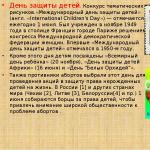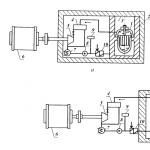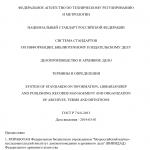Variable costs. What are variable and fixed costs of an enterprise? Fixed and variable costs
The manual is presented on the website in an abbreviated version. This version does not include testing, only selected tasks and high-quality assignments are given, and theoretical materials are cut by 30%-50%. I use the full version of the manual in classes with my students. The content contained in this manual is copyrighted. Attempts to copy and use it without indicating links to the author will be prosecuted in accordance with the legislation of the Russian Federation and the policies of search engines (see provisions on the copyright policies of Yandex and Google).
10.11 Types of costs
When we looked at the periods of production of a company, we said that in the short term the company can not change all the factors of production used, whereas in long term all factors are variable.
It is precisely these differences in the possibility of changing the volume of resources when changing production volumes that forced economists to divide all types of costs into two categories:
- fixed costs;
- variable costs.
Fixed costs(FC, fixed cost) are those costs that cannot be changed in the short term, and therefore they remain the same with small changes in the volume of production of goods or services. Fixed costs include, for example, rent for premises, costs associated with equipment maintenance, payments to repay previously received loans, as well as all kinds of administrative and other overhead costs. Let's say it is impossible to build a new oil refining plant within a month. Therefore, if next month an oil company plans to produce 5% more gasoline, then this is only possible on existing production facilities and with existing equipment. In this case, a 5% increase in output will not lead to an increase in equipment maintenance and maintenance costs. production premises. These costs will remain constant. Only the amounts of wages paid, as well as the costs of materials and electricity (variable costs) will change.
The fixed cost graph is a horizontal line.
Average fixed costs (AFC, average fixed cost) are fixed costs per unit of output.
Variable costs(VC, variable cost) are those costs that can be changed in the short term, and therefore they grow (decrease) with any increase (decrease) in production volumes. This category includes costs for materials, energy, components, and wages.
Variable costs show the following dynamics depending on the volume of production: up to a certain point they increase at a killing pace, then they begin to increase at an increasing pace.
The variable cost schedule looks like this:
Average variable costs (AVC, average variable cost) are variable costs per unit of output.
The standard Average Variable Cost graph looks like a parabola.
The sum of fixed costs and variable costs is total costs (TC, total cost)
TC = VC + FC
Average total costs (AC, average cost) are the total costs per unit of production.
Also, average total costs are equal to the sum of average fixed and average variable costs.
AC = AFC + AVC
AC graph looks like a parabola
A special place in economic analysis occupy marginal costs. Marginal cost is important because economic decisions usually associated with marginal analysis of available alternatives.
Marginal cost (MC, marginal cost) is the increment in total costs when producing an additional unit of output.
Since fixed costs do not affect the increment in total costs, marginal costs are also an increment in variable costs when producing an additional unit of output.
As we have already said, formulas with derivatives in economic problems are used when smooth functions are given, from which it is possible to calculate derivatives. When we are given individual points (discrete case), then we should use formulas with increment ratios.
The marginal cost graph is also a parabola.
Let's draw a graph of marginal costs together with graphs of average variables and average total costs:
The above graph shows that AC always exceeds AVC since AC = AVC + AFC, but the distance between them decreases as Q increases (since AFC is a monotonically decreasing function).
The graph also shows that the MC graph intersects the AVC and AC graphs at their minimum points. To justify why this is so, it is enough to recall the relationship between average and maximum values already familiar to us (from the “Products” section): when the maximum value is below the average, then the average value decreases with increasing volume. When the marginal value is higher than the average value, the average value increases with increasing volume. Thus, when the marginal value crosses the average value from bottom to top, the average value reaches a minimum.
Now let’s try to correlate the graphs of general, average, and maximum values:
These graphs show the following patterns.
Costs are formed differently depending on the type of resources used in production. Let us consider them using the example of the use of materials and production facilities of a manufacturing enterprise. washing machines. The more units of production are produced, the more material is consumed, therefore, the costs associated with the use of materials (metal, plastic, rubber) will increase. At the same time, the dimensions of the building and workshops, the volume of equipment do not change, which means that the costs associated with the use of the building and the equipment installed in the workshops may remain the same. Such differences in the use of production resources forced economists to consider such types of costs as fixed and variable.
Fixed costs- this is that part of total costs that does not depend at a given time on the volume of output.
An example of fixed costs could be a company's rent for premises, building maintenance costs, costs of training and retraining of personnel, wages management personnel, utility costs, depreciation.
Depreciation- reduction in the cost of capital resources as they wear out during production use. To compensate for the wear and tear of buildings, equipment, and vehicles, they accumulate cash (depreciation deductions), which are sent for repair or production of new means of labor instead of worn-out ones. These deduction amounts are included in fixed expenses.
The company incurs fixed costs even if it does not work. For example, if a bakery temporarily stopped the production of its products, then utilities and management salaries will still require expenses.
Variable costs- this is that part of the total costs, the value of which for a given period of time is directly dependent on the volume of production and sales of products.
Examples of variable costs are the costs of purchasing raw materials, labor, energy, fuel, transport services, costs of containers and packaging, etc.
Variable costs increase as production volume increases and decrease as production volume decreases.
The differences between fixed and variable costs are significant for every entrepreneur. He can manage variable costs, since their value changes over time. short term time as a result of changes in production volume. Fixed costs are beyond the control of the company's administration, since they are mandatory and must be paid regardless of the volume of production.
Analyzing changes in production costs depending on the volume of output is very important. Only on its basis can one understand how firms make decisions and determine the volume of production of goods and services, as well as set prices for goods offered on the market. Comparing production costs is extremely important for managing a company, determining optimal production sizes and opportunities for generating sustainable income.
So, participants entrepreneurial activity Those seeking to make their business efficient have to think about increasing profits and reducing costs. All of the above will help answer one more question: what does it mean? effective business, efficient enterprise(firm)? And although the concept of “efficiency” has already been used, let’s try to understand it better.
The concept of “effectiveness” comes from the word “effect”. In economics, an effect is a specific positive result of an activity (for example, an increase in profit received by a company compared to the previous year, or the amount of money saved). Efficiency is determined by comparing the magnitude of the effect and the costs (expenses, expenses) that ensure its receipt.
Efficiency is the effectiveness of a process, defined as the ratio of effect, result to costs. To analyze the efficiency and profitability of an enterprise, an indicator such as profitability is used. Profitability is calculated as the ratio of the profit received by an enterprise for a certain period to the costs incurred during the same period (profitability = profit: costs). Think about what needs to be done to achieve high efficiency of the company.
Enterprise expenses can be considered in the analysis from various points of view. Their classification is made on the basis of various characteristics. From the perspective of the influence of product turnover on costs, they can be dependent or independent of increased sales. Variable costs, the definition of which requires careful consideration, allow the head of the company to manage them by increasing or decreasing sales finished products. That's why they are so important to understand proper organization activities of any enterprise.
general characteristics
Variable Costs (VC) are those costs of an organization that change with an increase or decrease in the growth of sales of manufactured products.
For example, when a company ceases operations, variable costs should be zero. In order for a company to operate effectively, it will need to regularly evaluate its costs. After all, they influence the cost of finished products and turnover.
Such points.
- The book value of raw materials, energy resources, materials that are directly involved in the production of finished products.
- Cost of manufactured products.
- Salaries of employees depending on the implementation of the plan.
- Percentage from the activities of sales managers.
- Taxes: VAT, tax according to the simplified tax system, unified tax.
Understanding Variable Costs
In order to correctly understand such a concept as variable costs, an example of their definition should be considered in more detail. Thus, production is in the process of fulfilling its production programs spends a certain amount of materials from which the final product will be made.

These costs can be classified as variable direct costs. But some of them should be separated. A factor such as electricity can also be classified as a fixed cost. If the costs of lighting the territory are taken into account, then they should be classified specifically in this category. Electricity directly involved in the process of manufacturing products is classified as variable costs in the short term.
There are also costs that depend on turnover, but are not directly proportional production process. This trend may be caused by insufficient (or over) utilization of production, or a discrepancy between its designed capacity.
Therefore, in order to measure the effectiveness of an enterprise in managing its costs, variable costs should be considered as subject to a linear schedule along the segment of normal production capacity.
Classification

There are several types of variable cost classifications. With changes in sales costs, they are distinguished:
- proportional costs, which increase in the same way as production volume;
- progressive costs, increasing at a faster rate than sales;
- degressive costs, which increase at a slower rate with increasing production rates.
According to statistics, a company's variable costs can be:
- general (Total Variable Cost, TVC), which are calculated for the entire product range;
- average (AVC, Average Variable Cost), calculated per unit of product.
According to the method of accounting for the cost of finished products, a distinction is made between variables (they are easy to attribute to the cost) and indirect (it is difficult to measure their contribution to the cost).
Regarding the technological output of products, they can be production (fuel, raw materials, energy, etc.) and non-production (transportation, interest to the intermediary, etc.).
General variable costs
The output function is similar to variable cost. It is continuous. When all costs are brought together for analysis, the total variable costs for all products of one enterprise are obtained.

When common variables are combined and their total sum in the enterprise is obtained. This calculation is carried out in order to identify the dependence of variable costs on production volume. Next, use the formula to find variable marginal costs:
MC = ΔVC/ΔQ, where:
- MC - marginal variable costs;
- ΔVC - increase in variable costs;
- ΔQ is the increase in output volume.
Calculation of average costs
Average variable costs (AVC) are the company's resources spent per unit of production. Within a certain range, production growth has no effect on them. But when the design power is reached, they begin to increase. This behavior of the factor is explained by the heterogeneity of costs and their increase at large scales of production.
The presented indicator is calculated as follows:
AVC=VC/Q, where:
- VC - the number of variable costs;
- Q is the quantity of products produced.
In terms of measurement, average variable costs in the short run are similar to the change in average total costs. The greater the output of finished products, the more total costs begin to correspond to the increase in variable costs.
Calculation of variable costs
Based on the above, we can define the variable cost (VC) formula:
- VC = Material costs + Raw materials + Fuel + Electricity + Bonus salary + Percentage on sales to agents.
- VC = Gross profit - fixed costs.
The sum of variable and fixed costs is equal to the total costs of the organization.
The calculations of which were presented above participate in the formation of their overall indicator:
Total costs = Variable costs + Fixed costs.
Definition example

To better understand the principle of calculating variable costs, you should consider an example from the calculations. For example, a company characterizes its product output with the following points:
- Costs of materials and raw materials.
- Energy costs for production.
- Salaries of workers producing products.
It is argued that variable costs grow in direct proportion to the increase in sales of finished products. This fact is taken into account to determine the break-even point.
For example, it was calculated that it amounted to 30 thousand units of production. If you plot a graph, the break-even production level will be zero. If the volume is reduced, the company’s activities will move to the level of unprofitability. And similarly, with an increase in production volumes, the organization will be able to receive a positive net profit result.
How to reduce variable costs
The strategy of using “economies of scale”, which manifests itself when production volumes increase, can increase the efficiency of an enterprise.
The reasons for its appearance are the following.
- Using the achievements of science and technology, conducting research, which increases the manufacturability of production.
- Reducing management salary costs.
- Narrow specialization of production, which allows you to perform each stage of production tasks with better quality. At the same time, the defect rate decreases.
- Introduction of technologically similar product production lines, which will ensure additional capacity utilization.

At the same time, variable costs are observed below sales growth. This will increase the efficiency of the company.
Having become familiar with the concept of variable costs, an example of the calculation of which was given in this article, financial analysts and managers can develop a number of ways to reduce overall production costs and reduce production costs. This will make it possible to effectively manage the rate of turnover of the enterprise’s products.
Fixed and variable costs are the costs that a company incurs to produce goods, work or services. Their planning allows for more efficient use of available resources, as well as forecasting activities for the future.
Download and use it:
Fixed costs remain unchanged if the organization reduces production volume. In this case, the share of fixed costs per unit of production will increase. And vice versa - with an increase in production volumes, the share of fixed costs per unit of production will decrease. This indicator is average fixed costs (AFC).
Graphically, fixed costs can be represented as a straight line, since they remain unchanged with any changes in production (Fig. 1). Cm. .
Picture 1. Direct Cost Schedule
Variable costs
Variable costs depend on increases or decreases in production volumes. If an organization increases the number of products produced, the costs of materials and resources required for this increase accordingly.
Examples of variable costs:
- Wages of workers with a piece-rate wage system.
- Costs of raw materials and supplies.
- Transportation costs for delivering products to the consumer.
- Electricity costs, etc.
More on the topic:
How it will help: Find out which expenses should be cut. It will tell you how to audit business processes and inventory costs, and how to motivate employees to save.
How it will help: prepare a report in Excel on the expenses of a group of companies in the required detail - by business units, areas, items and periods
Variable costs change depending on changes in production volumes. With an increase in the number of products produced, variable costs will increase and, conversely, with a decrease in the number of products produced, they will decrease. Cm. .
The variable costs schedule looks like this - Fig. 2.
Figure 2. Variable cost schedule
At the initial stage, the growth of variable costs is directly related to the number of products produced. Gradually, the growth of variable costs is slowing down, which is associated with cost savings in mass production.
General costs
The sum of all costs, fixed and variable, that an organization spends on the production of goods or provision of services is called total costs (TC – total costs). They depend on the number of production volumes and the cost of resources spent on production. Graphically, total costs (TC) look like this - Fig. 3.
Figure 3.Graph of fixed, variable and total costs

An example of calculating fixed and variable costs
The company OJSC "Sewing Master" is engaged in sewing and selling clothes wholesale and retail. At the beginning of the year, the organization won a tender and entered into a long-term contract for a period of 1 year - a large order for sewing workwear for medical workers in the amount of 5,000 units per year. The organization incurred the following costs during the year (see table).
Table. Company costs
|
Type of costs |
Amount, rub. |
|---|---|
|
Rent sewing workshop |
50,000 rub. per month |
|
Depreciation charges according to accounting data |
48,000 rub. in a year |
|
Interest on a loan for the purchase of sewing equipment and necessary materials(fabrics, threads, sewing accessories, etc.) |
84,000 rub. in a year |
|
Utility costs for electricity, water supply |
18,500 rub. per month |
|
Cost of materials for sewing workwear (fabrics, threads, buttons and other accessories) |
|
|
Remuneration of workers (workshop staff amounted to 12 people) with an average wages 30,000 rub. |
360,000 rub. per month |
|
Remuneration of administrative staff (3 people) with average wages 45,000 rub. |
135,000 rub. per month |
|
Cost of sewing equipment |
Fixed costs include:
- rent for a sewing workshop;
- depreciation deductions;
- payment of interest on a loan for the purchase of equipment;
- the cost of the sewing equipment itself;
- administration salaries.
Calculation of fixed costs:
FC = 50,000 * 12 + 48,000 + 84,000 + 500,000 = 1,232,000 rubles per year.
Let's calculate average fixed costs:
Variable costs include the cost of raw materials and materials, wages for workers in the sewing workshop and payment for utility costs.
VC = 200,000 + 360,000 + 18,500 * 12 = 782,000 rubles.
Average variable costs will be:

The sum of fixed and variable costs will give total costs:
TC = 1232000 + 782000 = 20,140,00 rubles.
Average total costs are calculated using the formula:
Results
The organization has just started sewing production: rents a workshop, acquired sewing machines on credit. The amount of fixed costs at the initial stage is significant. The fact that production volume is still low - 5,000 units - also plays a role. Therefore, fixed costs still prevail over variable ones.
As production volumes increase, fixed costs will remain unchanged, but variable costs will increase.
Analysis and planning
Cost planning allows an organization to use existing resources rationally and more efficiently, as well as to predict its activities for the future (applies to the short-term period). Analysis is also necessary in order to determine where the most costly items of expenditure are and how savings can be made on the production of goods.
Saving on fixed and variable costs reduces the cost of production - an organization can set a lower price for its products than before, which increases the competitiveness of products in the market and increases attractiveness in the eyes of consumers (







